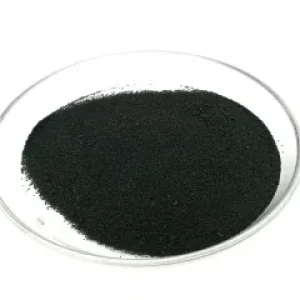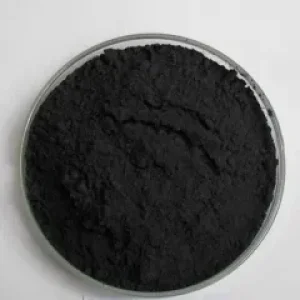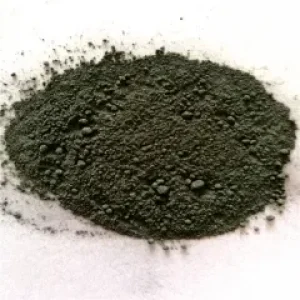Overview of Zirconium Carbide Powder
Zirconium carbide ZrC is an extremely hard refractory ceramic material commercially used for cutting tooltips. It is usually processed by sintering. Zirconium carbide is brittle. The zirconium carbide melting point is 3540°C. Zirconium carbide boiling point is 5100°C. The apparent density is 6.70 g/cm3. Mohs hardness 8-9. Insoluble in cold water and hydrochloric acid. It is soluble in hydrofluoric acid and hot concentrated sulfuric acid containing nitric acid or hydrogen peroxide. It reacts with chlorine at high temperatures to produce zirconium tetrachloride. At 700°C, it burns in the air to produce zirconia. Do not react with water.
ZrC powder is a gray metal powder with a cubic crystal structure. Highly corrosion resistant. The group IV interstitial transition metal carbides are also members of ultra-high temperature ceramics (UHTC). Due to the presence of metal bonds, ZrC has a thermal conductivity of 20.5 W/m·K and electrical conductivity (resistivity of ~43μΩ·cm), both of which are similar to zirconium metal. The strong Zr-C covalent bond gives the material a very high melting point (~3530°C), high modulus (~440 GPa), and hardness (25 GPa). Compared with other carbides such as WC (15.8 g/cm3), TaC (14.5 g/cm3) or HfC (12.67 g/cm3), ZrC has a lower density (6.73 g/cm3). ZrC seems suitable for reentry aircraft, rocket/hyperjet, or supersonic aircraft, where low density and high-temperature load-bearing capacity are critical requirements.
Like most carbides of refractory metals, zirconium carbide is substoichiometric. That is, it contains carbon vacancies. The material contains free carbon when the carbon content is higher than about ZrC0.98. The ratio of ZrC to carbon to metal is stable in the range of 0.65 to 0.98.
Product Performance of Zirconium Carbide Nanoparticles Nano ZrC Powder
Zirconium carbide nanoparticles ( CAS 12070-14-3 ) have high purity, small particle size, uniform distribution, large specific surface area, high surface activity, low bulk density, high-temperature resistance, oxidation resistance, high strength, high hardness, good toughness, and good thermal conductivity. Nano ZrC powder is an important high melting point, high strength, and corrosion-resistant high-temperature structural material, and it has the characteristics of efficiently absorbing visible light, reflecting infrared, and energy storage.
Technical Parameter of Zirconium Carbide Nanoparticles Nano ZrC Powder
| Product Name | MF | Purity | Particle Size | Crystal Form | SSA |
Color |
| Zirconium Carbide Nanoparticles | ZrC | 99% | 20nm | Cubic | 11m2/g |
Black |
Production Method of Zirconium Carbide ZrC Powder
Zirconium carbide can be manufactured in several ways. One method is the carbothermal reaction of zirconia and graphite. The result is powder. The dense ZrC can be made by sintering the ZrC powder at a temperature higher than 2000°C. Hot pressing of ZrC can lower the sintering temperature, thus helping to produce fine particles of completely dense ZrC. Spark plasma sintering has also been used to produce fully dense ZrC.
Zirconium carbide can also be manufactured by solution-based processing. This is achieved by refluxing the metal oxide and acetylacetone.
Another manufacturing method is chemical vapor deposition. This can be achieved by heating the zirconium sponge and decomposing the halide gas.
The poor oxidation resistance above 800°C limits the application of ZrC. One way to improve the oxidation resistance of ZrC is to prepare composite materials. The important composite materials proposed are ZrC-ZrB2 and ZrC-ZrB2-SiC composite materials. These composite materials can work at temperatures up to 1800°C. Another way to improve this situation is to use another material as a barrier layer, such as TRISO fuel particles.
Applications of Zirconium Carbide ZrC Powder
Zirconium carbide is a high melting point material with high hardness and excellent high-temperature refractory. Used as a material for solid fuel in rocket engines.Used in the production of alloy steel. It is also a raw material for producing zirconium and zirconium tetrachloride and promising fine ceramic materials. Zirconium carbide is used as an incandescent filament. Now, it is mainly used as an abrasive. It can also be used as raw materials for cemented carbide.
Zirconium carbide is commonly used in cutting tool heads as a hard refractory ceramic material. By sintering, zirconium carbide (ZRC) has high-temperature oxidation resistance, high strength, high hardness, good thermal conductivity, and toughness. In addition, zirconium carbide (ZrC) nanopowders have a high visible light absorption rate, excellent infrared reflectance, and large energy storage properties.
Coating material
ZrC-free and niobium carbide are used as refractory coatings in nuclear reactors. It has a low neutron absorption cross-section and is less sensitive to damage under radiation. It can coat uranium dioxide and OR dioxide particles in nuclear fuel. Coatings are usually deposited in a fluidized bed reactor by superheated chemical vapor deposition. It also has a high emissivity and high current capacity at high temperatures, making it a promising material for thermo-photoelectric radiators, field emitter tips, and arrays.
The cementing tools
Because of their hardness, cemented carbide compounds can be used for drills and other tools that require wear resistance. Zirconium carbide (ZrC) is an important high-temperature structural material with a high melting point, strength, and corrosion resistance. The application of cemented carbide can improve the strength and corrosion resistance of the material.
Nanostructured parts
Zirconium carbide nanoparticles can be used in the metallurgical, chemical, and aerospace industries in nanostructured parts. It can be used in the textile industry to manufacture nylon, fiber, and carbide thermostatic textiles. Composites used in ceramic and metal substrates are also made from these nanoparticles.
Company Profile
My Carbides is a trusted global chemical material supplier & manufacturer with over 12-year-experience in providing super high-quality carbides and relatives products.
The company has a professional technical department and Quality Supervision Department, a well-equipped laboratory, and equipped with advanced testing equipment and after-sales customer service center.
If you are looking for high-quality Carbides, please feel free to contact us or click on the needed products to send an inquiry.
Payment Methods of Zirconium Carbide Nanoparticles Nano ZrC Powder
L/C, T/T, Western Union, Paypal, Credit Card etc.
Shipment of Zirconium Carbide Nanoparticles Nano ZrC Powder
It could be shipped by sea, by air, or by reveal ASAP as soon as repayment receipt.
Package of Zirconium Carbide Nanoparticles Nano ZrC Powder
Vacuum packing, 100g, 500g or 1kg/bag, 25kg/barrel, or as your request.
FAQ
How hard is nano-zirconium carbide?
Answer: Nano-zirconium carbide has extremely high hardness and is one of the hardest materials known, which gives it significant advantages in preparing high-performance cutting tools and wear-resistant coatings.
What is the chemical stability of nano-zirconium carbide?
Answer: Nano-zirconium carbide has good chemical stability and can resist the erosion of various acids, alkalis and oxidants, so it can maintain stable performance in harsh environments.
What effect does the particle size of nanozirconium carbide have on its properties?
Answer: The particle size of nano-zirconium carbide has a significant impact on its performance. As the particle size decreases, its specific surface area increases and activity increases, but this may also lead to changes in mechanical properties.
How to improve the dispersion of nano-zirconium carbide?
Answer: Surface modification, ultrasonic treatment and other methods can be used to improve the dispersion of nano-zirconium carbide. These methods can effectively prevent the agglomeration of nanoparticles and improve their dispersion uniformity in the matrix.
What is the application effect of nano-zirconium carbide in coating materials?
Answer: As a coating material, nano-zirconium carbide can significantly improve the hardness, wear resistance and corrosion resistance of the coating. At the same time, its nanoscale effect can also improve the friction performance and fatigue resistance of the coating.
How toxic is nanozirconium carbide?
Answer: At present, there is insufficient research on the toxicity of nano-zirconium carbide, but based on its chemical stability and composition, it can be preliminarily judged that its toxicity is low. However, in practical applications, safety precautions still need to be taken to avoid long-term contact and inhalation










